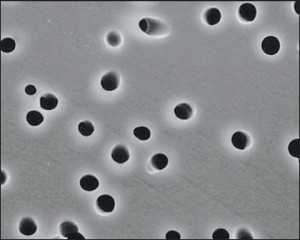Thin film track etched membranes, commonly referred to as polycarbonate (PCTE) and polyester (PET) filters, feature a unique pore structure and optical clarity unlike most filters. A complex, two step manufacturing process involving ion bombardment of the film followed by a chemical bath results in this attractive membrane exhibiting a smooth surface interrupted with the appearance of wrinkles, or rather waves, which may be concerning to first time users.
Waves are a structural artifact of the manufacturing process for these delicate yet durable membranes, made with very thin polymer films, less than half the thickness of a human hair. During the manufacturing process, long lengths of film are necessarily unwound and rewound into large rolls, multiple times. As a result of inhomogeneities in the material and slight fluctuations in thickness and tensile strength, waves occur while winding the material during the etching process. The more the roll is wound, the more intensive the





![Join Sterlitech at BIO 2024 [Booth #5558]: Exploring the Future of Biotechnology](https://www.sterlitech.com/media/magefan_blog/b4.jpeg)

